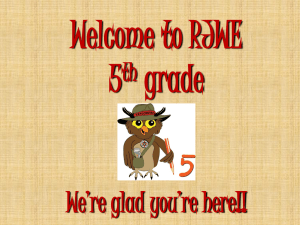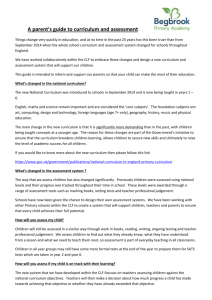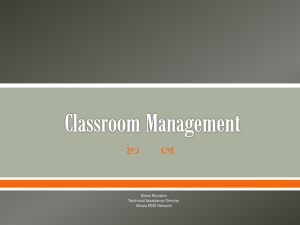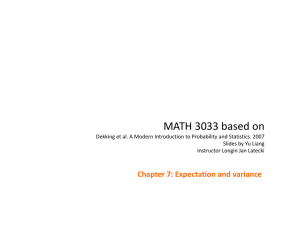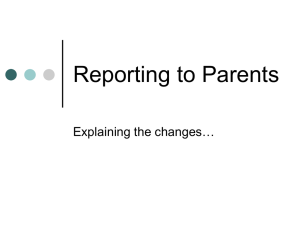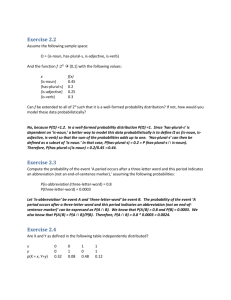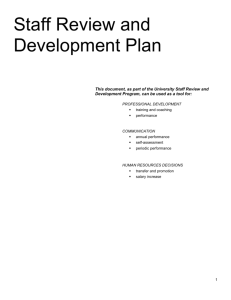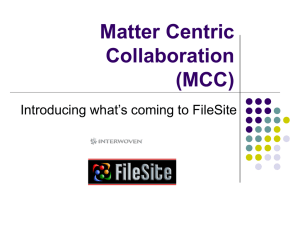Expectation Based Customer Oriented Marketing Mix- A
advertisement
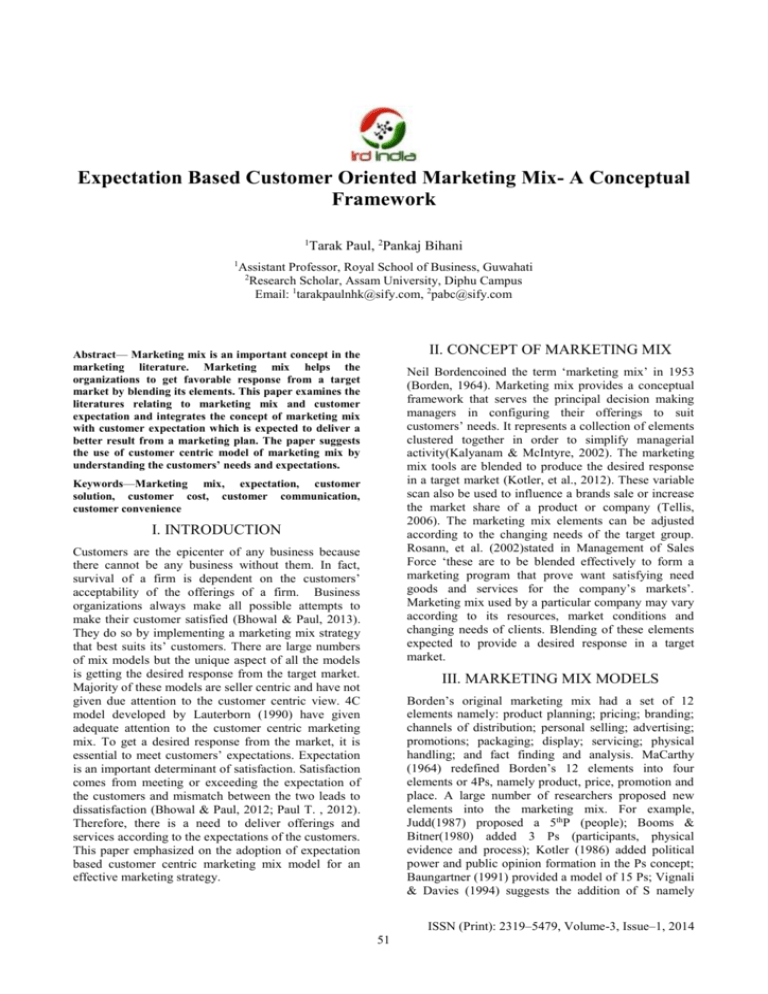
International Journal of Research and Development - A Management Review (IJRDMR) ________________________________________________________________________ Expectation Based Customer Oriented Marketing Mix- A Conceptual Framework 1 Tarak Paul, 2Pankaj Bihani 1 Assistant Professor, Royal School of Business, Guwahati 2 Research Scholar, Assam University, Diphu Campus Email: 1tarakpaulnhk@sify.com, 2pabc@sify.com II. CONCEPT OF MARKETING MIX Abstract— Marketing mix is an important concept in the marketing literature. Marketing mix helps the organizations to get favorable response from a target market by blending its elements. This paper examines the literatures relating to marketing mix and customer expectation and integrates the concept of marketing mix with customer expectation which is expected to deliver a better result from a marketing plan. The paper suggests the use of customer centric model of marketing mix by understanding the customers’ needs and expectations. Neil Bordencoined the term ‘marketing mix’ in 1953 (Borden, 1964). Marketing mix provides a conceptual framework that serves the principal decision making managers in configuring their offerings to suit customers’ needs. It represents a collection of elements clustered together in order to simplify managerial activity(Kalyanam & McIntyre, 2002). The marketing mix tools are blended to produce the desired response in a target market (Kotler, et al., 2012). These variable scan also be used to influence a brands sale or increase the market share of a product or company (Tellis, 2006). The marketing mix elements can be adjusted according to the changing needs of the target group. Rosann, et al. (2002)stated in Management of Sales Force ‘these are to be blended effectively to form a marketing program that prove want satisfying need goods and services for the company’s markets’. Marketing mix used by a particular company may vary according to its resources, market conditions and changing needs of clients. Blending of these elements expected to provide a desired response in a target market. Keywords—Marketing mix, expectation, customer solution, customer cost, customer communication, customer convenience I. INTRODUCTION Customers are the epicenter of any business because there cannot be any business without them. In fact, survival of a firm is dependent on the customers’ acceptability of the offerings of a firm. Business organizations always make all possible attempts to make their customer satisfied (Bhowal & Paul, 2013). They do so by implementing a marketing mix strategy that best suits its’ customers. There are large numbers of mix models but the unique aspect of all the models is getting the desired response from the target market. Majority of these models are seller centric and have not given due attention to the customer centric view. 4C model developed by Lauterborn (1990) have given adequate attention to the customer centric marketing mix. To get a desired response from the market, it is essential to meet customers’ expectations. Expectation is an important determinant of satisfaction. Satisfaction comes from meeting or exceeding the expectation of the customers and mismatch between the two leads to dissatisfaction (Bhowal & Paul, 2012; Paul T. , 2012). Therefore, there is a need to deliver offerings and services according to the expectations of the customers. This paper emphasized on the adoption of expectation based customer centric marketing mix model for an effective marketing strategy. III. MARKETING MIX MODELS Borden’s original marketing mix had a set of 12 elements namely: product planning; pricing; branding; channels of distribution; personal selling; advertising; promotions; packaging; display; servicing; physical handling; and fact finding and analysis. MaCarthy (1964) redefined Borden’s 12 elements into four elements or 4Ps, namely product, price, promotion and place. A large number of researchers proposed new elements into the marketing mix. For example, Judd(1987) proposed a 5thP (people); Booms & Bitner(1980) added 3 Ps (participants, physical evidence and process); Kotler (1986) added political power and public opinion formation in the Ps concept; Baungartner (1991) provided a model of 15 Ps; Vignali & Davies (1994) suggests the addition of S namely ISSN (Print): 2319–5479, Volume-3, Issue–1, 2014 51 International Journal of Research and Development - A Management Review (IJRDMR) ________________________________________________________________________ service to the marketing mix. Sheth & Shah(2003)proposed 4A’s concept stating that customers who intend to purchase should have Acceptance, Affordability, Accessibility and Awareness. component of cost, but not the total cost. Price represents the price fixed by a seller while customer cost includes all other associated cost in addition to the price. The cost other than price may include all those cost required for acquiring the products for actual use. In some cases such cost may be a substantial part of the total cost which should not be ignored. The traditional models have failed to recognize this fact which was considered as relevant by 4C model. Thus, price of a product shows the seller centric view while customer cost represents the buyers’ centric view. IV. CUSTOMER CENTRIC MARKETING MIX MODEL 4P model is producer centric and criticized by number of studies. Rafiq & Ahmed (1995) observed a high degree of dissatisfaction with the 4P model. 4Ps marketing mix variables have no relation to customers and that make it relatively void (Gronroos, 1994; Dixon & Blois, 1983).Lauterborn (1990)stated that for a successful marketing plan customers must be placed in the center of the marketing plan. He replaced 4Ps by 4Cs which focus on the customer centric view of marketing. The 4Cs are - Customer needs, Convenience, Cost and Communication. Paul (2012 &Rousey & Morganosky(1996)supported the 4Cs concept by stressing on the replacement of the 4Ps by Lauterborn’s 4 C. Customer Communication The 4Cs suggested by Lauterborn (1990) are Customer needs, Convenience, Cost and Communication. The unique feature of 4C concept is that it addresses customers’ needs(Miller, et al., 2002). The following four elements were proposed in the 4C model. In marketing, communications consists of all the promotional elements which involve the communications between an organisation and its target audiences (Kotler & Keller, 2006).The role of marketing communications is to support the marketing plan and help the key audiences to understand the marketer’s advantage over the competition (Shimp, 2000). Marketing communications can provide information to create points of difference and allow brands to stand out and help consumers appreciate their comparative advantages(Keller, 2008). The communication model adopted by an organisation should be a customer centric. The customer communication focuses on the two-sided communication and includes all those strategy that is desired by a customer form the company. All promotional activities adopted by a company for communicating with the customers need re-modeling depending on what type of promotional strategy the customers expect from the companies. Customer communication element of 4C marketing mix framework provides a comprehensive sense of promotional activities from customer view point. Thus, from discussion it can be inferred that marketing mix model has under gone several changes since its inception. The 4C approach, being a customer centric approach, better study and understand the customer from varies aspects. V. 4C’S OF MARKETING MIX Customer Solution: The concept of customer convenience dimension of 4C marketing mix model is the reformation of place dimension of 4P marketing mix. Place concept of 4P marketing mix refers to the availability of the products to the target customer customers(Kotler, et al., 1999). Customer convenience concept is based on the paradigm of providing convenience to the customers’ while buying/using the products or services. The customer convenience concept emphasizes on the fact that customers are interested in the convenience they actually require rather the place of availability of the products or services. Customer convenience element of 4C marketing mix framework has provided a comprehensive sense to place concept from customer view point. The customer solution concept is based on the fact that customers are interested in the solution of their problem in the form of need rather than the products and services offered by a company. Wolcott & Arroniz (2006)termed solution “as a customized, integrated combination of products, services and information that solves a customer’s problem.” Customer want solutions to problems they face in their lives. True customer focus requires marketers to begin with a customer problem, and work towards creating solutions that address these problems (Sawhney, 2004).Customer solution is a better approach it believes in offering the products as per customers’ requirement. On this ground, it is said that customer solution can serve customer better by designing customer oriented solution in form of products and services. Customer convenience VI. CUSTOMER EXPECTATION Customer Cost: Expectation is the beliefs about a product’s attributes or performance at some time in the future (Rust, et al., 1999)and always is a key element of satisfaction (Oliver & Winer, 1987).A Customer forms Customer cost represents a comprehensive approach of looking the total cost incurred by a customer for buying goods or services. The price is an essential ISSN (Print): 2319–5479, Volume-3, Issue–1, 2014 52 International Journal of Research and Development - A Management Review (IJRDMR) ________________________________________________________________________ expectations from many sources such as previous experience, word of mouth and advertising (Anderson & Sullivan, 1993). Researchers have found a diminishing effect of the gap between performance and expectations on consumer satisfaction (Mittal, et al., 1998).Meeting the expectations of customers will cement the relationships, increase customers’ satisfaction and retain their business. Nazare (2012)pointed out that business firms can no longer be indifferent to their customer’s need and expectation and hence business units should meet customers’ expectation in order to achieve the target customers’ satisfaction. Seth & Mittal (1996)stated that a firm’s customer may have unjustified, unfeasible and unproductive expectation. Thus, their expectation should be shaped rather than fulfilled. Oloka(2012)stated mentioned that how customers’ expectations are met or surpassed by a company’s products and services measures the Customers’ satisfaction. Dimension of 4C marketing mix. Asian Journal of Research in Marketing, 3(1), pp. 183-194. [6] Booms, B. H. & Bitner, B. J., 1980. Marketing Strategies and Organisation Structure. In: J. Donnelly & W. R. George, eds. Marketing of Services. s.l.:American Marketing Association, pp. 47-51. [7] Borden, N. H., 1964. The Concept of Marketing Mix. Journal of Avertising Research, Volume 2, pp. 7-12. [8] Dixon, D. F. & Blois, K. J., 1983. Some Limitations of the 4P's as a Paraigm for Marketing, In Back to Basics, Proceeding of the Marketing Eucation Group. UK, Cranfield School of Management, Cranfield University [9] Gronroos, C., 1994. Quo Vadis, Marketing? Toward a Relationship Marketing Paraigm. Journal of Marketing Management, 10(5), pp. 347-360. [10] Judd, V. C., 1987. Differentiate With the 5th P: People. Industrial Marketing Management, 16(4), pp. 241-247. [11] Kalyanam, K. & McIntyre, S., 2002. The EMarketing Mix: a Contribution of the E-Tailing Wars. Academy of Marketing Science Journal , 30(4), pp. 487-499. [12] Keller, K. L., 2008. Strategic Brand Management. 12th ed. Upper Saddle River, New Jersey: Prentice Hall. [13] Kotler, P., 1986. Principles of Marketing. 3rd ed. New Jersy: Prentice Hall [14] Kotler, P. & Armstrong, G., 1996. Principles of Marketing. 7th ed. Upper Saddle River, New Jersey: Prentice-Hall. [15] Kotler, P., Armstrong, G., Sunders, J. & Wrong, V., 1999. Principles of Marketing. 2nd European Edition ed. Upper Sadle River, NJ: Prentice Hall Inc. [16] Kotler, P. & Keller, K. L., 2006. Marketing Management. 12th ed. Upper Saddle River, NJ: Prentice-Hall [17] Bhowal, A. & Paul, T., 2012. Mental Accounting of Retail Investor and Marketing Mix- A Tango. Reflection, 1(1), pp. 39-48. Kotler, P., Keller, K. L., Koshy, A. & Jha, M., 2012. Marketing Management A south Asian Perspective. 13th ed. New Delhi: Pearson Publications. [18] Bhowal, A. & Paul, T., 2013. Gaps in Customer Solution - A case stuy of Mutual funds in India. The SAMS Journal, 7(1), pp. 33-41. Lauterborn, B., 1990. New Marketing Litany: Four Ps Passe: C- Wors Take Over. Avertising Age, 61(41), p. 26. [19] MaCarthy, E. J., 1964. Basic Marketing, IL. Irwin: Richard. [20] Miller, D., Hope, Q., Eisentat, R. & Gilbraith, J., 2002. The problem of solutions: Balancing VII. CONCLUSION From the above discussion, it can be concluded that customers’ expectation should always be given special attention along with the use of a customer centric marketing plan. Service providers do their best to make the customers satisfied but still dissatisfaction is found among customers(Bhowal & Paul, 2013). Customers deserves the products that are expected to provide solution of their needs/problems, affordable cost to satisfy their needs, proper communication required for acquiring a product and finally convenience in acquring the product. Therfore, we suggest an integrated approach of customer centric marketing mix coupled with customers’ expectation which is expected to deliver better service to the customers. This study leaves scope for further research in the areas of understaning what and how expectations are created and the cognitive process involved in it. REFERENCES [1] [2] [3] [4] [5] Anderson, E. W. & Sullivan, M. W., 1993. The Antecedent and Consequence of customer satisfactions for Firms. Marketing Science, 12(2), pp. 125-143. Baungartner, J., 1991. Nonmarketing Professionals Need More Than 4Ps,. Marketing News, 22(July), p. 28. Bhowal, A. & Paul, T., 2014. Mutual Fund Investors’ Expectation and Experience Gap A study from the 'Customer Convinence' ISSN (Print): 2319–5479, Volume-3, Issue–1, 2014 53 International Journal of Research and Development - A Management Review (IJRDMR) ________________________________________________________________________ clients and capabilities. Business Horizons, Volume 2, pp. 3-12. [21] Mittal, V., Ross, W. T. & Baldasare, P. M., 1998. The Asymmetric Impact of Negative and Positive Attribute-Level Performance on Overall Satisfaction and Repurchase Intentions. Journal of Marketing, Volume 62(January), pp. 33-47 [22] Nazare, M., 2012. Prioritizing the Effective Factors of Customer’s Satisfaction. International Journal of Business and Management, 7(2), pp. 236-242. [23] Oliver, R. L. & Winer, R. S., 1987. A Framework for the Formation and Structure of Consumer Expectations: Review and Propositions. Journal of Economic Psychology, Volume 8 (December), pp. 469-499. [24] Oloka, M., 2012. Influence of Relationship Marketing on Performance of Commercial Banks in Keneya. Education Research Journa, 2(2), pp. 37-42. [25] [26] [27] [28] Survey of UK and European Acaemics. Marketing Intelligence & Planning, 13(9), pp. 4-15. Paul, T., 2012. A Study on level of Expectation of Mutual Fund Investors and the Impact of Demographic profile on Period of Investment. International Journal of research in Commerce and Management, 3(7), pp. 136-139. Paul, T., 2012. An Assessment of Gap Between Expectation an Experience of Mutual Fun Investors. International Journal of Marketing, Financial Services an Management Research, 1(7), pp. 10-21. Paul, T., 2014. Paul, Tarak, Retail Investors Participation in Indian Mutual Fund Industry A Matter of Concern. [Online] Available at: http://ssrn.com/abstract=2395728 [Accessed 21 2 2014]. Paul, T. & Bajaj, S., 2012. A Study on level of Expectation of Mutual Fund Investors & Impact of Demographic Profile on Period of Investment in Mutual Fund. International Journal of Research in Commerce & Management, 3(7), pp. 136-139. [29] Perreaualt, W. D. & McCarthy, J. E., 1999. Basic Marketing: A Global Managerial Approach. Boston: McGraw-Hill. [30] Rafiq, M. & Ahmed, P. K., 1995. Using 7Ps as a Generic Marketing Mix: An Exploratory [31] Rosann, L. S., Stanton, W. J. & Greg, A., 2002. Rosann L Spiro, William J Stanton (2002), Greg A. Rich Management of a Sales Force. Irwin: McGraw-Hill. [32] Rousey, S. P. & Morganosky, M. A., 1996. Retail Format Changes in US Markets. International Journal of Retail & Distribution Management, 24(3), pp. 8-16. [33] Rust, R. T., Inman, J. J., Jia, J. & Zahorik, A., 1999. Rust, Roland T., Jeffrey J. Inman, Jianmin Jia, and Anthony Zahorik (1999), “What You Don’t Know About Customerperceived Quality: The Role of Customer Expectation Distributions. Marketing Science, 18(`), pp. 77-92. [34] Sawhney, M., 2004. Going Beyond the Product: Defining, Designing and. [Online]. [35] Seth, J. N. & Mittal, B., 1996. A Framework for Managing Expectation. Journal of Market Focused Management, Volume 1, pp. 137-158. [36] Sheth, J. N. & Shah, R. H., 2003. Till death o us part...but not always: Six antecedents to a customer’s relational preference in buyer-seller exchanges. Industrial Marketing Management , 8(32), pp. 627-631. [37] Shimp, A. T., 2000.. Advertising Promotion and Supplemental Aspects of Integrated Marketing Communications. Forth Worth: The Druden Press. [38] Tellis, G. J., 2006. Modeling Marketing Mix. [Online] Available at: http://wwwbcf.usc.edu/~tellis/ mix.pdf [Accessed 2011 July 12]. [39] Vignali, C. & Davies, B. J., 1994. The Marketing Mix Redefined and MappedIntroducing the MIX MAP Model. Management Decisions, 32(8), pp. 11-16. [40] Wolcott, R. C. & Arroniz, I., 2006. The 12 Different Ways for Companies to Innovate. The 12 Different Ways for Companies to Innovate MIT Sloan Management Review, Volume 47 (Spring), pp. 75-81. ISSN (Print): 2319–5479, Volume-3, Issue–1, 2014 54
